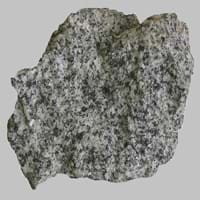Oolite and Diorite
Definition
Definition
Oolite is a sedimentary rock formed from ooids, spherical grains which are composed of concentric layers of calcite
Diorite is a grey to dark-grey intermediate intrusive igneous rock composed principally of plagioclase feldspar,biotite, hornblende, and pyroxene
History
Discoverer
Unknown
Unknown
Etymology
From oo- + -lite, after German Oolit. A rock consisting of fine grains of carbonate of lime
From early 19th century coined in French, formed irregularly from Greek diorizein distinguish
Class
Sedimentary Rocks
Igneous Rocks
Sub-Class
Durable Rock, Medium Hardness Rock
Durable Rock, Hard Rock
Family
Group
Volcanic
Plutonic
Other Categories
Fine Grained Rock, Opaque Rock
Coarse Grained Rock, Medium Grained Rock, Opaque Rock
Texture
Texture
Clastic or Non-Clastic
Phaneritic
Color
Black, Blue, Brown, Cream, Green, Grey, Pink, Red, Silver, White, Yellow
Black, Brown, Light to Dark Grey, White
Maintenance
Less
Less
Durability
Durable
Durable
Water Resistant
No
No
Scratch Resistant
Yes
No
Stain Resistant
Yes
No
Wind Resistant
No
Yes
Acid Resistant
No
No
Appearance
Rounded and Rough
Shiny
Uses
Architecture
Interior Uses
Decorative Aggregates, Flooring, Interior Decoration
Decorative Aggregates, Interior Decoration
Exterior Uses
As Building Stone, As Facing Stone, Garden Decoration, Paving Stone
As Building Stone, As Facing Stone, Garden Decoration
Other Architectural Uses
Not Yet Used
Curbing
Industry
Construction Industry
Cement Manufacture, Cobblestones, Landscaping
As Dimension Stone, Cement Manufacture, Cobblestones, Construction Aggregate, for Road Aggregate
Medical Industry
Not Yet Used
Not Yet Used
Antiquity Uses
Artifacts
Artifacts, Monuments, Sculpture, Small Figurines
Other Uses
Commercial Uses
Creating Artwork, Jewelry, Used in aquariums
Creating Artwork, Curling
Types
Types
Not Available
Not Available
Features
Available in lots of colors, Generally rough to touch, Very fine grained rock
Typically speckled black and white.
Archaeological Significance
Monuments
Not Yet Used
Used
Famous Monuments
Not Applicable
Data Not Available
Sculpture
Not Yet Used
Used
Famous Sculptures
Not Applicable
Data Not Available
Pictographs
Used
Not Used
Petroglyphs
Used
Not Used
Figurines
Not Yet Used
Used
Fossils
Present
Absent
Formation
Formation
Oolites form when layers of calcite are deposited around a sand grain or fossil piece and are rolled around in calm water, which makes them round.
Diorite is a coarse-grained intrusive igneous rock which contains large interlocking and randomly oriented crystals and forms when molten lava does not reach the Earth’s surface and cools down in the Earth’s crust.
Composition
Mineral Content
Calcite, Chert, Clay, Dolomite, Quartz, Sand, Silt
Albite, Amphibole, Apatite, Biotite, Feldspar, Hornblade, Ilmenite, Magnetite, Muscovite or Illite, Olivine, Plagioclase, Pyroxene, Quartz, Sulfides, Titanite, Zircon
Compound Content
Aluminium Oxide, Ca, NaCl, CaO, Iron(III) Oxide, FeO, MgO
Silicon Dioxide
Transformation
Metamorphism
No
Yes
Types of Metamorphism
Not Applicable
Cataclastic Metamorphism, Contact Metamorphism, Regional Metamorphism
Weathering
Yes
Yes
Types of Weathering
Biological Weathering, Chemical Weathering, Mechanical Weathering
Biological Weathering, Chemical Weathering, Mechanical Weathering
Erosion
Yes
Yes
Types of Erosion
Chemical Erosion, Coastal Erosion
Chemical Erosion, Coastal Erosion, Water Erosion
Properties
Physical Properties
Hardness
3-4
6-7
Grain Size
Fine Grained
Medium to Coarse Grained
Fracture
Conchoidal
Not Available
Streak
White
Bluish Black
Porosity
Less Porous
Very Less Porous
Luster
Pearly to Shiny
Shiny
Compressive Strength
Not Available
225.00 N/mm2
7
Cleavage
Non-Existent
Not Available
Toughness
1
2.1
Specific Gravity
Not Available
2.8-3
Transparency
Opaque
Opaque
Density
Not Available
2.8-3 g/cm3
Thermal Properties
Resistance
Heat Resistant, Wear Resistant
Heat Resistant, Pressure Resistant, Wear Resistant
Reserves
Deposits in Eastern Continents
Asia
Brunei, India, Indonesia, Malaysia, Singapore, Thailand, Vietnam
Not Yet Found
Africa
Cameroon, Chad, Ghana, Kenya, Malawi, Sudan, Tanzania, Togo, Zambia, Zimbabwe
Egypt
Europe
United Kingdom
Finland, Germany, Italy, Romania, Sweden, Turkey, United Kingdom
Others
Not Yet Found
Not Yet Found
Deposits in Western Continents
North America
USA
USA
South America
Colombia
Argentina, Bolivia, Chile, Colombia, Ecuador, Peru
Deposits in Oceania Continent
Australia
Adelaide, New Zealand, Queensland, Tonga, Victoria, Yorke Peninsula
New Zealand, Western Australia
All about Oolite and Diorite Properties
Know all about Oolite and Diorite properties here. All properties of rocks are important as they define the type of rock and its application. Oolite belongs to Sedimentary Rocks while Diorite belongs to Igneous Rocks.Texture of Oolite is Clastic or Non-Clastic whereas that of Diorite is Phaneritic. Oolite appears Rounded and Rough and Diorite appears Shiny. The luster of Oolite is pearly to shiny while that of Diorite is shiny. Oolite is available in black, blue, brown, cream, green, grey, pink, red, silver, white, yellow colors whereas Diorite is available in black, brown, light to dark grey, white colors. The commercial uses of Oolite are creating artwork, jewelry, used in aquariums and that of Diorite are creating artwork, curling.
|
||
|
||
|










